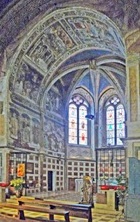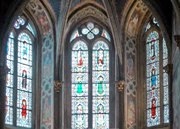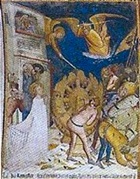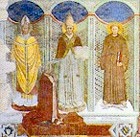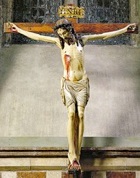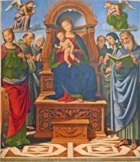This chapel at the end of the narthex was documented in 1338 and again in 1343: in the latter document. it was referred to as the “new chapel” that had been built by “donne continenti”, who were presumably female Franciscan tertiaries. The construction of this chapel required the closing off of the passage that led from the narthex to the papal palace in the Sacro Convento.
When the papal legate, Cardinal Gil Albornoz died at Viterbo on 23rd August, 1367, the citizens of Assisi carried his body in state to San Francesco, where he was buried, as he had requested, in the Cappella di Santa Caterina. In December 1367, his heirs paid 500 florins to Matteo di Giovannello, il Gattapone for the repair of the chapel. In 1368, they paid 450 florins to ‘Andreas pictor de Bononia’ (probably Andrea de’ Bartoli) for painting its frescoes and a further 10 florins for painting his tomb there. [The cardinal's hat that is suspended from the roof of the chapel commemorates him.] (The historical context is set out in the page on San Francesco in the 14th century).
The body of Cardinal Albornoz was taken to Toledo in 1372.
Stained glass (ca. 1325)
A number of standing saints are depicted in the three stained glass bifore windows of the chapel.
-
✴The glass in central bifore is attributed to Giovanni di Bonino and dated before the stained glass (1325-34) that he executed in the Duomo, Orvieto. St Catherine appears with the Madonna and Child in the top register.
-
✴The glass in the other two bifores is of lower quality, but probably dates to the same period.
Frescoes (ca. 1368)
In 1368, the year after the death of Cardinal Albornoz, his heirs paid ‘Andreas pictor de Bononia’ 450 florins for painting the frescoes in this chapel and a further 10 florins for painting his tomb here. This artist was probably Andrea de’ Bartoli, who is documented in 1369 at the Collegio di Spagna, Bologna, which Cardinal Albornoz had founded in 1364 and further endowed in his will.
Scenes from the life of St Catherine of Alexandria
These eight scenes are on the walls and under the entrance arch of the chapel. They include this scene, in which angels destroy the wheel on which St Catherine was to be martyred (under the arch, on the left).
Standing Saints
These two fictive triptychs are under the entrance arch, with one on each side of the chapel. The depict:
-
✴SS Sabinus, Clement and Francis (on the left, illustrated here); and
-
✴SS Blaise, Eugene (of Toledo?) and Louis of Toulouse.
In the scene on the left, the kneeling Cardinal Albornoz lays his cardinal’s hat at the feet of St Clement, who wears a papal tiara: this is a reference to Pope Clement VI, who had created him Cardinal Priest of San Clemente in 1350.
Crucifix (15th century)
Art from the Chapel
Madonna and Child with saints (1516-7)
The Minister General of the Franciscan Third Order commissioned this altarpiece from
Giovanni di Pietro, lo Spagna for the Cappella di Santa Caterina. It depicts the Madonna and Child with SS Catherine of Alexandria, Francis and Elizabeth of Hungary on the left and the Blessed Giles (?), and SS Clare and Louis IX on the right. The altarpiece is now in the
Museo del Tesoro.


